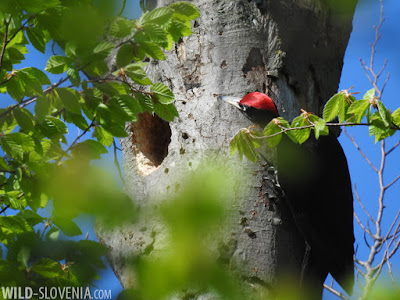It's that exciting time of year again! When that magic substance called chlorophyll is the absolute dominator and everything turns green again. Over the past week we've been enjoying the spring awakening of wildlife in the Karst, usually quite close to home, in the surroundings of Sežana and Divača. The vegetation season is late this year, approximately 10 days later than usual, but by now, real spring seems to have finally kicked in. The Karst's woodlands are slowly turning to a pleasant light green, while some woodlands closer to the coast have already did so a week ago. In woodlands the time of vernal flowers is almost over, but the spectacle has now moved out in the open, on dry
karstic grasslands that are becoming alive with spring colours. The
first orchids have appeared and we have already seen Pale-flowered
Orchis pallens & Green-winged Orchids Anacamptis morio.
On the bird front there is, as usual, the joy of the first returning summer migrants enliving woodlands and orchards such as Cuckoo Cuculus canorus, Hoopoe Upupa epops, Wryneck Jynx torquilla, Nightingale Luscinia megarhynchos, Scops Owl Otus scops, Common Whitethroat Sylvia communis, Wood Warbler Phylloscopus sibilatrix, Whinchat Saxicola rubetra, Common Redstart Phoenicurus phoenicurus, Alpine Swift Apus melba ect. Of the more interesting migrants we already observed a male Red-footed Falcon Falco vespertinus and the first Bee-eaters Merops apiaster of the season. A Black Stork Ciconia nigra and a Griffon Vulture Gyps fulvus migrating over Sežana were also noteworthy. Here are some photos...
On the bird front there is, as usual, the joy of the first returning summer migrants enliving woodlands and orchards such as Cuckoo Cuculus canorus, Hoopoe Upupa epops, Wryneck Jynx torquilla, Nightingale Luscinia megarhynchos, Scops Owl Otus scops, Common Whitethroat Sylvia communis, Wood Warbler Phylloscopus sibilatrix, Whinchat Saxicola rubetra, Common Redstart Phoenicurus phoenicurus, Alpine Swift Apus melba ect. Of the more interesting migrants we already observed a male Red-footed Falcon Falco vespertinus and the first Bee-eaters Merops apiaster of the season. A Black Stork Ciconia nigra and a Griffon Vulture Gyps fulvus migrating over Sežana were also noteworthy. Here are some photos...
Hoopoe Upupa epops - we've seen and heard several birds in a few days, including the one in the lower pic, feeding behind our house (clearly a migrant).
Cuckoo Cuculus canorus - the woods are finally echoing with their songs. Note the photobombing by a curious Yellowhammer Emberiza citrinella in the lower pic.
Beech Fagus sylvatica - fresh green leaves are sprouting in the wetter forests of the Karst.
Fire Salamander Salamandra salamandra
Black Woodpecker Dryocopus martius - this pair is still busy with nest-hole excavation.
Black Woodpecker Dryocopus martius - this pair is still busy with nest-hole excavation.
Pale-flowered Orchid Orchis pallens in a patch of broadleaved woodland near Divača. This is a rather scarce species in Slovenia, but locally it can grow in denser stands. It is also one of the first spring orchids to emerge.
Wrynecks Jynx torquilla are back in the orchards and vineyards.
Nightingales Luscinia megarhynchos are also back from Africa and their melodious songs (watch the video) can be commonly heard in the Karst's shrubland and warmer broadleaved woodlands.
Sessile Oak Quercus petraea with blossoming Wild Cherries Prunus avium.
Wood Warbler Phylloscopus sibilatrix - a regular migrant in broadleaved woodlands.
Red-footed Falcon Falco vespertinus (male) - a passage migrant in small numbers at some grassland areas of the Karst. Their peak migration time in Slovenia is at the end of April and beginning of May, when large flocks gather at such sites as Cerkniško jezero and Ljubljansko barje.
Black Stork Ciconia nigra - soaring over Lipica; a rare passage migrant to the Karst.
Green-winged Orchid Anacamptis morio - the commonest orchid on dry limestone grasslands.
Pheasant's-eye Narcissus Narcissus poeticus ssp. radiiflorus - like every year, some meadows are carpeted with them.
Black Stork Ciconia nigra - soaring over Lipica; a rare passage migrant to the Karst.
Green-winged Orchid Anacamptis morio - the commonest orchid on dry limestone grasslands.
Pheasant's-eye Narcissus Narcissus poeticus ssp. radiiflorus - like every year, some meadows are carpeted with them.
Mountain Pasqueflower Pulsatilla montana is a typical early spring species of karstic grasslands. In the photo it is surrounded by Compact Grape-hyacinth Muscari botryoides.
"Trieste's Gentian" Gentiana verna ssp. tergestina - an endemic subspecies inhabiting dry grasslands of western Slovenia, northeastern Italy and northwestern Croatia (named after the city of Trieste).
Tommasini's Cinquefoil Potentilla tommasiniana - another Illyrian-Balkanic endemic, named after M. Tommasini, a 19th century botanist from Trieste. Common species on dry karstic grasslands.
Fritillaria orientalis - increasingly scarce species of dry limestone grasslands in the Karst.
Globularia Globularia punctata - a common spring flower on dry grasslands.
Bear's Ear Primula auricula - an alpine species growing rarely also in some Karstic dolines (sinkholes) as an ice age relict.
Dalmatian Algyroides Algyroides nigropunctatus - a rather common lizard of limestone habitats along the eastern Adriatic coasts. In Slovenia it reaches the north-westernmost edge of distribution.
Southern Festoon Zerynthia polyxena - this attractive butterfly can be commonly found in some grassland areas of the Karst, where its food plant (Aristolochia sp.) grows. However it can be quite tricky to photograph as it frequently rests in the tall grass.
Southern Festoon Zerynthia polyxena - this attractive butterfly can be commonly found in some grassland areas of the Karst, where its food plant (Aristolochia sp.) grows. However it can be quite tricky to photograph as it frequently rests in the tall grass.
Orange Tip Anthocharis cardamines
Green Hairstreak Callophrys rubi
Green-veined White Pieris napi
Read more about the Karst and its grasslands on our website.
































